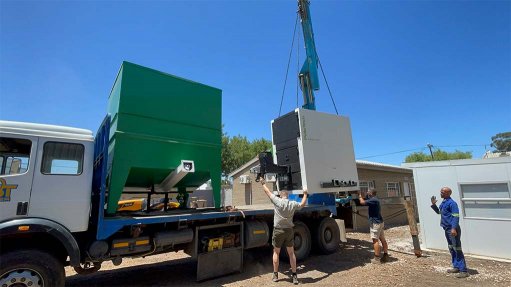
LOADING MASS Biomass-fueled systems being loaded to a transport for delivery to an agriculture company in Worcester, Western Cape
Biomass fuel manufacturer and distributor Calore Sustainability Energy (CSE) Biomass, a division of clean energy provider Earth & Wire, started the new year with installations at two agriculture companies in Worcester, in the Western Cape.
The first installation includes two 350 kW hot-air generators, installed last month, and the second installation a 2 200 kW wood chip-fuelled boiler system, to be installed in April.
CSE Biomass planning and development engineer Dr Ruan van der Westhuizen adds that the company also has several other projects that are nearing financial close.
Established to meet the increased demand for wood pellets in the industrial market, CSE Biomass developed and began operating a wood pellet factory at a working sawmill in the Eastern Cape, in 2018.
The company processes offcuts and dust from the sawmill into biomass pellets, which are then used as a fuel source for boilers in various industrial sectors.
Van der Westhuizen says it is necessary to use a specially designed boiler that caters for the difference in combustion characteristics between coal and wood to harness all the benefits offered by wood pellets and wood chips over coal.
He explains that a biomass combustion system consists of a fuel bunker, a fuel infeed mechanism, a combustion chamber with heat exchanger and an ash extraction mechanism.
“A solid-fuel combustion system is generally more complicated than a gas- or liquid-fuel combustion system, but offers a similar degree of automation once in operation,” he enthuses.
Wood pellets have notable flow characteristics and can, therefore, be fed into the boiler from a hopper using only an attached auger screw. Wood chips, which tend to clump together, additionally need an agitator, walking floor or raking mechanism to assist in transporting the wood chips from the fuel bunker into the boiler,” says Van der Westhuizen.
Green Wood
It is important for CSE Biomass that the sawmill uses pine from Forest Stewardship Council-approved plantations to produce their pellets, because this ensures that the fuel is environment-friendly.
Sources used to produce wood chips include product obtained from the clearing of alien and invasive trees, orchard and vineyard recycling, as well as other waste wood, Van der Westhuizen adds.
He defines waste wood as wood that is destined to be destroyed either through burning on a heap in the open air or through decay.
“Burning waste wood in the open air creates heavy pollution and wastes energy that could have been used productively elsewhere.”
He points out that decaying wood releases methane, which is known to be a more harmful greenhouse gas than carbon dioxide (CO2).
Efficient combustion releases mostly CO2 and, therefore, efficiently burning waste wood can be considered as a better alternative to disposal through decay.
Meanwhile, CSE Biomass also has a network of local partners that can manufacture and install auxiliary elements of the system, as well as combustion technology partners based in Europe.
Van der Westhuizen concludes that further collaborations include agricultural product supplier Africa Biomass Company – an incorporated partner of CSE Biomass – which has the largest fleet of privately owned woodchippers in Africa, with a processing capacity exceeding 400 000 t/y.